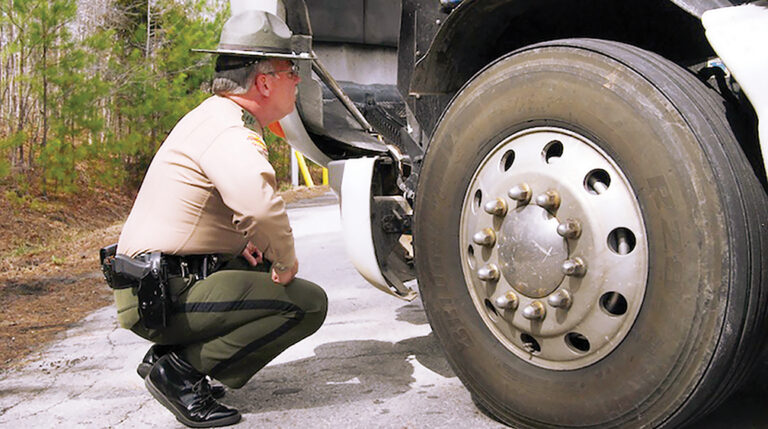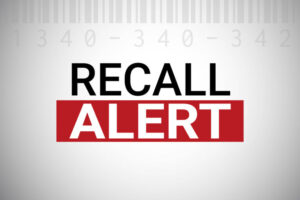WASHINGTON — Over the three days of the Commercial Vehicle Safety Alliance’s (CVSA) International Roadcheck commercial motor vehicle inspection and enforcement initiative, held May 17-19, inspectors conducted 59,026 inspections and placed 12,456 commercial motor vehicles and 3,714 commercial motor vehicle drivers out of service.
A commercial motor vehicle is placed out of service when an inspector finds critical vehicle inspection item out-of-service violations, which are outlined in CVSA’s North American Standard Out-of-Service Criteria, during a roadside inspection. Being placed out of service means the driver or vehicle is prohibited from operation for a specified period of time or until the violation is corrected.
This year, inspectors in Canada and the U.S. conducted 36,555 Level I Inspections and inspectors in Mexico conducted 1,150 Level V Inspections, for a combined total of 37,705 Level I and V Inspections, according to a CVSA news release.
They placed 8,718 vehicles out of service, which is a 23.1% vehicle out-of-service rate for North America. Out of the 48,966 Level I and II Inspections conducted in Canada and the U.S., 11,181 vehicles were placed out of service, which is a 22.8% vehicle out-of-service rate, and 3,118 drivers were placed out of service, which is a 6.4% driver out-of-service rate.
That also means that 77.2% of the vehicles and 93.6% of the drivers inspected did not have out-of-service violations. Vehicles that do not have any critical vehicle inspection item violations, after a Level I or V Inspection, are eligible to receive a CVSA decal.
The CVSA decal, valid for up to three consecutive months after inspection, is a visual indicator that signals to inspectors that the vehicle has “passed inspection.” Inspectors distributed 14,200 CVSA decals, which were placed on 10,135 power units, 3,876 trailers and 189 motorcoaches.
All Inspection Levels
On May 17-19, inspectors conducted a total of 58,287 North American Standard Inspections, which consisted of:
- 36,555 Level I Inspections – This 37-step process checks the driver’s operating credentials and requirements and the vehicle’s mechanical fitness and regulatory compliance.
- 12,411 Level II Inspections – This inspection involves reviewing the driver’s operating credentials and requirements and includes only vehicle inspection items that can be inspected without the inspector physically getting under the vehicle.
- 8,171 Level III Inspections – This is the driver credentials and operating requirements inspection.
- 1,150 Level V Inspections – This inspection involves vehicle inspection items and may be conducted without a driver present, at any location.
Level I Inspections
During International Roadcheck, inspectors in Canada and the U.S. primarily conduct the Level I Inspection, which is a comprehensive 37-step inspection process that involves thorough inspection of the vehicle (including underneath the vehicle) and the driver’s operating credentials.
- Of the 36,555 Level I Inspections conducted in Canada and the U.S., 23.7% of the vehicles inspected (8,672) were placed out of service and 6.1% (2,242) of drivers were placed out of service.
- In the U.S., of the 33,196 Level I Inspections were conducted, 7,912 commercial motor vehicles (23.8%) and 2,051 drivers (6.2%) were placed out of service.
- In Canada, of the 3,359 Level I Inspections were conducted, 760 commercial motor vehicles (22.6%) and 191 (5.7%) drivers were placed out of service.
Level V Inspections
For International Roadcheck, inspectors in Mexico conducted 1,150 Level V Inspections. The Level V Inspection includes each of the vehicle inspection items specified under the North American Standard Level I Inspection and may be conducted without a driver present, at any location. Thirty-six commercial motor vehicles were placed out of service, which is a 3.1% out-of-service rate.
Vehicle Violations
Top Five Vehicle Out-of-Service Violations Combined (Canada, Mexico and the U.S.)
| Violation Category | # of OOS Vehicle Violations | % of OOS Vehicle Violations |
| Brake Systems | 4,592 | 25.2% |
| Tires | 3,374 | 18.5% |
| Defective Service Brakes | 2,309 | 12.7% |
| Lights | 2,219 | 12.2% |
| Cargo Securement | 1,934 | 10.6% |
Top Five Vehicle OOS Violations – U.S.
| Violation Category | # of OOS Vehicle Violations | % of OOS Vehicle Violations |
| Brake Systems | 3,992 | 24.0% |
| Tires | 3,227 | 19.4% |
| Defective Service Brakes | 2,142 | 12.9% |
| Lights | 2,084 | 12.5% |
| Cargo Securement | 1,647 | 9.9% |
Top Five Vehicle OOS Violations – Canada
| Violation Category | # of OOS Vehicle Violations | % of OOS Vehicle Violations |
| Brake Systems | 588 | 38.0% |
| Cargo Securement | 287 | 18.6% |
| Defective Service Brakes | 161 | 10.4% |
| Lights | 133 | 8.6% |
| Tires | 126 | 8.2% |
Top Five Vehicle OOS Violations – Mexico
| Violation Category | # of OOS Vehicle Violations | % of OOS Vehicle Violations |
| Tires | 21 | 45.7% |
| Brake Systems | 12 | 26.1% |
| Defective Service Brakes | 6 | 13.0% |
| Wheels | 4 | 8.7% |
| Lights | 2 | 4.3% |
Driver Out-of-Service Violations
Top Five Driver Out-of-Service Violations – Combined (Canada and the U.S.)
| Violation Category | # of OOS Driver Violations | % of OOS Driver Violations |
| False Logs | 1,921 | 42.6% |
| Wrong Class License | 1,066 | 23.6% |
| Hours of Service | 367 | 8.1% |
| Suspended License | 260 | 5.8% |
| No Medical Card | 222 | 4.9% |
Top Five Driver OOS Violations – U.S.
| Violation Category | # of OOS Driver Violations | % of OOS Driver Violations |
| False Logs | 1,901 | 45.0% |
| Wrong Class License | 1,045 | 24.7% |
| Suspended License | 251 | 5.9% |
| No Medical Card | 222 | 5.3% |
| Other | 205 | 4.9% |
Top Five Driver OOS Violations – Canada
| Violation Category | # of OOS Driver Violations | % of OOS Driver Violations |
| Hours of Service | 219 | 76.3% |
| Wrong Class License | 21 | 7.3% |
| False Logs | 20 | 7.0% |
| Suspended License | 9 | 3.1% |
| Violation License Restriction (tied) | 6 | 2.1% |
| Drugs (tied) | 6 | 2.1% |
Hazardous Materials/Dangerous Goods (HM/DG) Out-of-Service (OOS) Violations
HM/DG OOS Violations – Combined (Canada and the U.S.)
| Violation Category | # of OOS HM/DG Violations | % of OOS HM/DG Violations |
| Loading | 95 | 35.1% |
| Placards | 57 | 21.0% |
| Shipping Papers | 42 | 15.5% |
| Package Integrity | 35 | 12.9% |
| Training Certification | 16 | 5.9% |
HM/DG OOS Violations – U.S.
| Violation Category | # of OOS HM/DG Violations | % of OOS HM/DG Violations |
| Loading | 91 | 40.4% |
| Placards | 48 | 21.3% |
| Package Integrity | 35 | 15.6% |
| Shipping Papers | 31 | 13.8% |
| Other HM | 14 | 6.2% |
HM/DG OOS Violations – Canada
| Violation Category | # of OOS HM/DG Violations | % of OOS HM/DG Violations |
| Training Certification | 16 | 34.8% |
| Shipping Papers | 11 | 23.9% |
| Placards | 9 | 19.6% |
| Loading | 4 | 8.7% |
| Bulk Package (tied) | 3 | 6.5% |
| Markings (tied) | 3 | 6.5% |
Focus Area – Wheel Ends
Each year, CVSA highlights a certain aspect of the roadside inspection. This year, the focus was on wheel ends. Out of the top 10 vehicle out-of-service violations, tires ranked second and wheels came in seventh. Of the 18,213 total vehicle out-of-service violations, there were 3,374 tire out-of-service violations, accounting for 18.5% of all vehicle out-of-service violations, and there were 784 wheel out-of-service violations, which is 4.3% of all vehicle out-of-service violations. Combined, wheel end (tire and wheel) violations accounted for 22.8% of all out-of-service vehicle violations throughout North America.
Tire and Wheel OOS Vehicle Violations
| Country | Violation Category | # of OOS Violations | % of OOS Violations |
| North America | Tires | 3,374 | 18.5% |
| U.S. | Tires | 3,227 | 19.4% |
| Canada | Tires | 126 | 8.2% |
| Mexico | Tires | 21 | 45.7% |
| North America | Wheels | 784 | 4.3% |
| U.S. | Wheels | 721 | 4.3% |
| Canada | Wheels | 59 | 3.8% |
| Mexico | Wheels | 4 | 8.7% |
Seatbelt Usage
Last year, there were more than 50,000 “failure to use a seatbelt while operating a commercial motor vehicle” driver violations, according to the U.S. Federal Motor Carrier Safety Administration’s (FMCSA) Motor Carrier Management Information System. It was the fourth most-cited driver violation in 2021, accounting for 4.99% of the total number of driver violations. During the three days of International Roadcheck, inspectors checked safety belt usage during inspections and identified 472 seatbelt violations.
Since its inception in 1988, more than 1.8 million roadside inspections have been conducted during International Roadcheck campaigns. International Roadcheck is a CVSA program with participation by the Federal Motor Carrier Safety Administration, the Canadian Council of Motor Transport Administrators, Transport Canada, and Mexico’s Ministry of Communications and Transportation and the National Guard.
View International Roadcheck results from previous years.
The Trucker News Staff produces engaging content for not only TheTrucker.com, but also The Trucker Newspaper, which has been serving the trucking industry for more than 30 years. With a focus on drivers, the Trucker News Staff aims to provide relevant, objective content pertaining to the trucking segment of the transportation industry. The Trucker News Staff is based in Little Rock, Arkansas.














